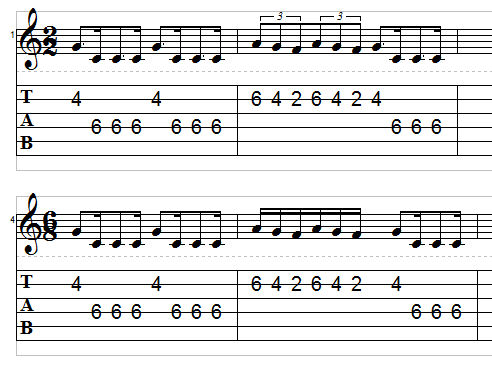Quote:
Originally Posted by rick-slo

The score was meant to be played as written
|
But "as written", in this case, means (almost certainly) allowing that dotted 8ths stand for triplet feel, in the tradition brahmz118 outlined. Do you dispute his post?
If so, why do you think this song should be an exception?
Quote:
Originally Posted by rick-slo

and that is how it is being played in the examples previously given.
|
as you hear it. Not as most of us seem to hear it.
Quote:
Originally Posted by rick-slo

The score is more readable in 6/8 than 2/2, not less.

|
That isn't the correct use of 6/8 at all! While it sounds correct like that, it's unnecessarily busy to read, and a 6/8 sig makes no sense with those note placements.
To write it in 6/8, one wouldn't convert a 2/2 measure into one 6/8 measure, but into
two measures of 6/8. (You seem to have missed the parts of my posts which described that.) So the above excerpt would be 4 measures of 6/8.
The alternative would be two measures of 12/8 which - IMO - would be a little harder to read than either 4 measures of 6/8, or the original 2/2.
Quote:
Originally Posted by rick-slo

That the publisher would change the timing in the published sheet music to fit 2/2 even though it should be "understood" to be something else (and in most cases to be understood to be something else by the general public no less) makes no sense at all and is an absurd claim IMO.
|
The publisher isn't "changing" anything.
They (and/or the composer himself) is using the convention of "dotted 8th+16th to be played as triplet 2+1 8ths" (quarter+8th with triplet marking, or three 8ths as in a half measure of 6/8).
Quote:
Originally Posted by rick-slo

From the original publisher here is sheet music (orchestrated) from 1950 (the year the tune was written)

|
OK, that's in 4/4 throughout, so the later edition has added the 2/2 marking. But it still uses the "dotted 8th = triplet" convention we're talking about (which dates from well before 1950, and lasted well beyond that). There's no indication of this, of course, but the implication is clear - from the "lilt" marking, the triplets here and there in the melody... and of course the simple fact it's an Irish pastiche!
Quote:
Originally Posted by rick-slo

The song is performed with this timing in the recordings I have come across, not modified into something else.
|
Well, my ears tell me it's performed in triplet feel. That's not a "modification" of the notation, it's an acceptance of the dotted 8th shorthand.
Quote:
Originally Posted by rick-slo

|
Yes, that's one of the ones I found. Clearly 6/8 (all triplets in the backing behind the vocal).
Quote:
Originally Posted by rick-slo

|
Sorry I don't think it matches.
It is a very small difference between the drums (dotted 8ths) and the 6/8 backing rhythm, but enough to jar, to my ears.
Quote:
Originally Posted by rick-slo

I might add for any lingering doubters that the wavefore of the recording (as seen in Audacity for example) shows the time given to each word, which again matches the score).
|
I doubt very much that the visible timing of the words in Audacity (the start point of each syllable0)would be crisp enough to be so sure of a difference between 6/8 triplets and 3+1 16ths. One could easily interpret it either way.
At this tempo (around 120), the difference in placement between the last 8th of a triplet and the last 16th of a beat would be 1/24 of a second. You can hear that difference in a drum part, but in vocals the attack portion of a syllable is more gradual.
IOW, I remain a "lingering doubter". I'm impressed with your efforts to back up your conviction, but none of it convinces me. In fact, the audio examples only support the triplet feel.